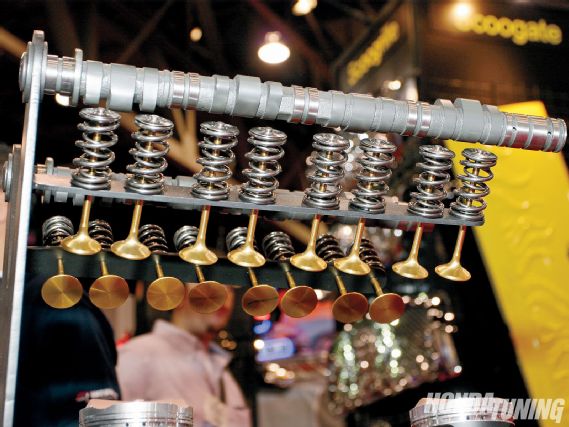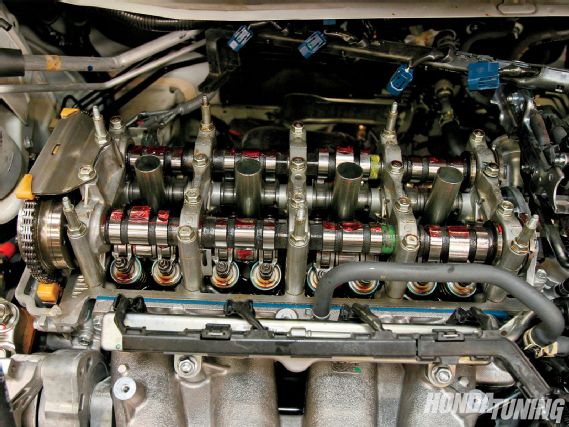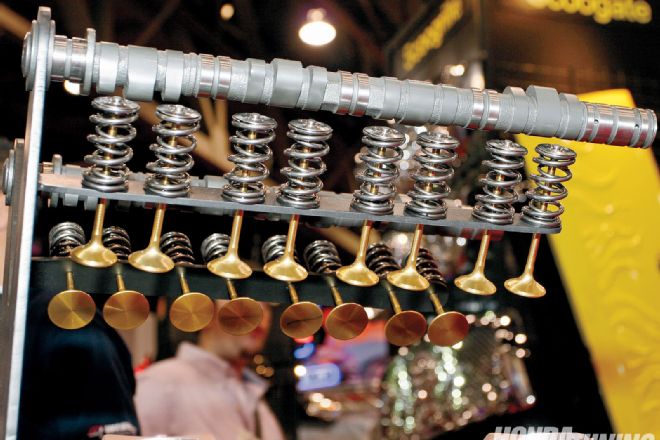Technical
Worldwide, Honda enthusiasts invest hundreds, if not thousands of dollars on their powerplants to extract the utmost in power and reliability. Whether they opt to keep their Honda naturally aspirated, super charged, nitrous-fed, or turbocharged, the Honda base engines respond very well to proper modifications. Here at Bisimoto Engineering, we provide services of parts and tuning on the most aggressive camshafts, the craziest induction systems, and the most bizarre boost level turbo systems. However, one of the most overlooked components in the average Honda fan's arsenal is the valve spring set.
 |
Performance Valve Springs - Spring Into Action
|
Performance Valve Springs - Spring Into Action
Valvetrain components are the most crucial elements in allowing the utmost in safe, reliable power production. Think about this, the internal combustion engine is simply a chemical, to heat, to mechanical energy converter. The "chemicals" involved are diatomic oxygen (contained in air to the tune of almost 21 percent), and the hydrocarbon based fuel. Heat of combustion then performs work on the piston crown which is then translated to mechanical energy via the crankshaft. The key to making power is to harness these energies as efficiently as possible, especially in conservation of the maximized heat created by the combustion process.
The control of pre and post combustion elements into and out of the cylinder head lies primarily in the camshaft. In addition, the cam profile is critical to engine performance in both forced induction and naturally aspirated engines. So you contact a company like Bisimoto, order the perfect level or custom cam for your application, and then just slap it in, right? Above and beyond the proper lash and degreeing settings recommended by the manufacturer, it is imperative to also invest in the proper valve spring and retainer package.
Companies like Supertech and Bisimoto research heavily in design, preparation, and testing of valvetrain components. In this day and age of high revving Honda engines, using the proper valve spring combination can determine the life or death of the performance Honda powerplant. The valve springs allow for ideal control of the intake and exhaust valves, so that (via the rocker arm) the profile of the camshaft is followed properly. This is even more critical in valves with increased mass, like oversized or "flat faced/high compression" valves. If the valve inertia overcomes the resistance of the valve spring, then a phenomenon known as "valve float" and "valve bounce" can occur. Valve float, in simple terms, is an environment where the valve "ski jumps" off the cam profile ramp, particularly after peak lift. This is very prevalent in high rpm boosted and all motor engines, even with factory camshafts and valve springs. This float manifests itself in a sudden power loss in high rpms, bent valve stems, cracked valve guides, and in a worst case scenario, piston-to-valve and valve-to-valve contact. The latter are extremely damaging to engines, and can wreck havoc on the pistons, combustion chamber, and turbocharger (when used). Valve bounce is when the valve attempts to close to the seat and just simply "bounces" off of it. This will result in a power loss as well, poor valve seal due to seat damage, and in rare cases, piston to valve contact.
In addressing some myths, it is a common misconception that simply installing a stiffer set of springs is the way to go. As a matter of fact, this is only one piece of the puzzle. Even though seat pressures can go a long way in curbing valve bounce, harmonics and valvetrain mass play a key role in valve train stability. Buying springs just based on stiffness can be worse than using factory components. If the spring's natural frequency is compromised by the frequency of the valve/cam combo, float will occur as well. The answer: only use companies that have reputable valve spring windings. Bisimoto Engineering, for example, tests all its valve train windings to over 14,000 rpm in extended harsh conditions on a Spintron testing device. This ensures that the coil spring windings can take the abuse, and will not induce float in the most demanding of conditions. You'd be surprised at how many popular companies do not even know how to perform this simple test, and sell springs that often fail. Lighter valves, light weight chromoly, aluminum or the very popular titanium retainers also allow for lighter valvetrain mass to keep float and bounce at bay. Aluminum is not as popular due to its short service intervals. Titanium is a great choice, however heat treated titanium, like those that Bisimoto Engineering provides, is even better in providing improved longevity and resilience to galling.
 |
Performance Valve Springs - Spring Into Action
|
Performance Valve Springs - Spring Into Action
Another misconception is that dual valve springs are a must in high performance applications. The truth is that the installed height of the spring plays a huge role in the single vs. dual design. This height is the distance from the spring seat base to the spring retainer base when the spring is installed in the head, with retainers and keepers in place. With a high enough installed height, like in the D16Z6 engine (53.165-53.635mm on the intake), a properly designed single spring will provide ideal seat and max open valve pressure. The B18C1 has an intake installed height of 37.465-37.935mm and would pose much difficulty to provide ideal seat and open pressures without binding the valve spring, hence a dual valve spring assembly is ideal.
The last, but not least, misconception is that boosted applications do not require aftermarket valve spring assemblies. Turbocharged and supercharged engines have an additional variable that places more challenges to valve spring components: boost. This intake pressure also acts against the intake valve head, especially during compression and exhaust cycles, and hence aftermarket turbo and supercharged systems truly require valve spring and retainer upgrades for optimum performance. Since increased heat is also a by-product of forced induction, spring annealing (softening) can also occur, especially in factory springs that have seen over 50,000 or more miles of road service. Bottom line, upgrade your valve springs, at a minimum, when turbocharging your vehicle!
When choosing components for your next build, carefully select the right ingredients that would make your project worthwhile, reliable, and enjoyable. Valve springs and retainers are very key components for your engine, and should be given as much thought as the camshaft and other related components. By purchasing from the right company, with proven R&D, you will set up you vehicle to "spring into action" on the street or track.
About the author
'Bisi Ezerioha is the founder and owner of Bisimoto Engineering, located in Ontario, CA. He holds an Associate's degree in Natural and Applied Sciences, a B.Sc degree in Chemical Engineering and M.Sc degree in Engineering Management. He currently holds multiple racing world records, is an avid motorsports components designer, inventor, and engine tuner.
 |
Performance Valve Springs - Spring Into Action
|
Performance Valve Springs - Spring Into Action

